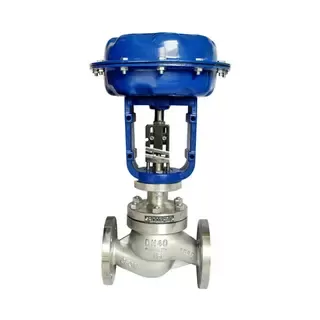Notifications

7 minutes, 4 seconds
-12 Views 0 Comments 0 Likes 0 Reviews

We are a leading control valves manufacturer in China, delivering high-quality valves and control actuators customized to meet a wide range of industrial requirements.
In today’s rapidly advancing landscape of process automation and industrial fluid management, achieving precision, reliability, and effective control is crucial for optimal system performance. The pneumatic single-seated control valve stands out as a key component engineered to deliver high accuracy and low leakage, making it indispensable in applications demanding stringent flow regulation and dependable operation under diverse conditions.
This article offers a thorough overview of pneumatic single-seated control valves, highlighting their structural advantages, operational principles, industry applications, and essential performance features. Whether you are an engineer, plant manager, or procurement professional, understanding the design and capabilities of this valve type is vital for selecting the most suitable control solution for your processes.
A single-seated control valve features a linear motion design that regulates fluid flow by adjusting a single plug relative to a single seat. Compared to double-seated valves, the single-seat configuration provides superior shutoff performance and enhanced control precision, making it ideal for sensitive and critical applications.
This valve type minimizes leakage through a streamlined internal architecture with fewer leak paths. Its top-guided stem design stabilizes the valve core during operation, enabling smooth, accurate flow modulation. Typically, single-seated valves are chosen for applications requiring high rangeability, tight shutoff, and rapid response to control signals.
The compact valve body includes a precision-machined flow path designed to reduce pressure loss and fluid turbulence, resulting in improved flow capacity, higher efficiency, and precise control of variables such as pressure, temperature, and flow rate.
Pneumatic single-seated valves utilize compressed air actuators to position the valve plug in response to control signals, offering quick and reliable operation widely adopted in process industries. Key benefits include:
High Flow Accuracy: Compliant with IEC 534-2-1976 standards for precise flow characteristics.
Tight Shut-Off: Meets ANSI B16.104 standards to ensure minimal leakage.
Broad Operating Range: Performs consistently across varying temperatures and pressure differentials.
Media Versatility: Suitable for gases, steam, corrosive liquids, and slurries.
Compact and Lightweight: Reduced footprint and simplified maintenance due to fewer components.
The valve operates via a pneumatic diaphragm actuator controlled by a positioner receiving signals typically in the 4–20 mA range or pneumatic signals from a process control system. Upon receiving the signal, the actuator moves the stem, adjusting the valve plug position relative to the seat to regulate flow.
An S-shaped flow channel inside the valve minimizes resistance and pressure drops, enhancing energy efficiency and reducing noise. The upper-guided structure keeps the stem and plug precisely aligned throughout operation, improving durability, responsiveness, and reducing wear.
Pneumatic single-seated control valves are used across diverse industries thanks to their reliable and accurate control capabilities:
Oil and Gas: Regulating hydrocarbons, gas injection, and vapor recovery with minimal leakage in high-pressure environments.
Chemical Processing: Managing aggressive and corrosive fluids with precision and corrosion resistance.
Power Generation: Controlling steam flow, feedwater, and boiler operations under high temperatures.
Pharmaceuticals: Maintaining sterile processing conditions with electric-free, clean pneumatic actuation.
Food and Beverage: Ensuring hygienic, leak-proof operation with compact, sanitary designs.
Upper-Guided Structure: Stabilizes stem and plug to minimize wear and enhance longevity.
High Flow Capacity & Low Pressure Loss: S-shaped flow channel increases flow coefficient (Cv) by ~30%, reducing noise and vibration.
Compact Actuator: Multi-spring diaphragm design cuts actuator size and weight by up to 30%, simplifying installation and upkeep.
Leakage Performance:
Metal-to-metal seats meet ANSI Class IV standards for moderate shutoff.
Soft seat options achieve ANSI Class VI tight shutoff for zero leakage.
Wide Rangeability: Turndown ratio up to 50:1 accommodates fluctuating process conditions.
Bellows Seal Option: Provides zero stem leakage for sensitive or fugitive emission-critical applications.
Insulation Jacket (Optional): Maintains media temperature to prevent crystallization or blockages.
Valve bodies and trims come in a variety of materials, including:
Body: WCB, CF8, CF8M, Alloy 20, Hastelloy, Monel, etc.
Trim: Hardened stainless steel, Stellite coatings, soft seats.
Seals: PTFE, EPDM, Viton, metal seals based on temperature and chemical compatibility.
Actuators can be customized with:
Pneumatic or electro-pneumatic positioners
Limit switches
Air filter regulators
Manual handwheels
This ensures seamless integration with existing automation and process requirements.
The simplified internal structure results in easier maintenance with fewer failure points. Benefits include:
Extended service life due to guided stem motion and reduced wear.
Lower total cost of ownership through efficient, reliable operation.
Many models allow top-entry maintenance without removing the valve body, reducing downtime.
Pneumatic single-seated control valves embody precision engineering excellence for industrial flow control. Their compact, guided design, high accuracy, broad operating range, and leak-tight performance make them a versatile choice for various industries.
Whether in oil and gas, chemical processing, pharmaceuticals, or power generation, these valves provide the dependable modulation and durability essential for smooth, efficient process control.
Investing in high-quality pneumatic single-seated control valves means committing to operational excellence, reduced downtime, and improved process consistency over the long term.Know more about Google SEO Directory

